Itinerary edited by SAPIENZA UNIVERSITY OF ROME 

Let us stop, look, wonder why, try to understand. Perhaps we no longer have time for all this (or we just don't feel like it). We rush along roads and motorways, grumbling about the traffic, time, work, without ever seeing the present, without ever perceiving the past. And yet the landscape rich in forms crafted by the millennial action of Earth's forces, the rocks and the fossils which they contain, tell us incredible stories and evoke fantastical scenes. The Tiber Valley transforms into a deep sea, fiery clouds roll over the valley, rainforests gradually turn into woodlands and prairies inhabited by long extinct, exotic fauna.
This itinerary aims to propose a dynamic sequence of ancient scenes, to tell the story of a land's evolution through the fossil remains (carnivores, elephants, rhinos, hippopotamuses, giant deer, bisons, aurochs, etc.) on display at the Museum of Palaeontology, an overview of the succession of environments between approximately 5 million and 10,000 years ago. In particular, the aim is to show the change of terrestrial paleoenvironments in the geographic area which today corresponds to the Lower and Middle Tiber Valley and the Rome basin, from the Late Pliocene, when tectonics caused the sea to retreat and lap the shores of the newly formed chain of the Apennines, when the climate was still hot and humid, and luxurious forests stretched out in the vicinity of marsh areas inhabited by tapirs and primitive proboscidea... However, this world had already began to change... the coast line was already retreating, then came the rivers, volcanoes. The Tiber changed its course, over time new mammals arrived from Asia, Africa and the Indian subcontinent, due to changes in the climate and landscape, right up until its current configuration (Figure 1).
Figure1 - Schematic representation of the main rocky bodies of Lazio seen from high above, from South to North
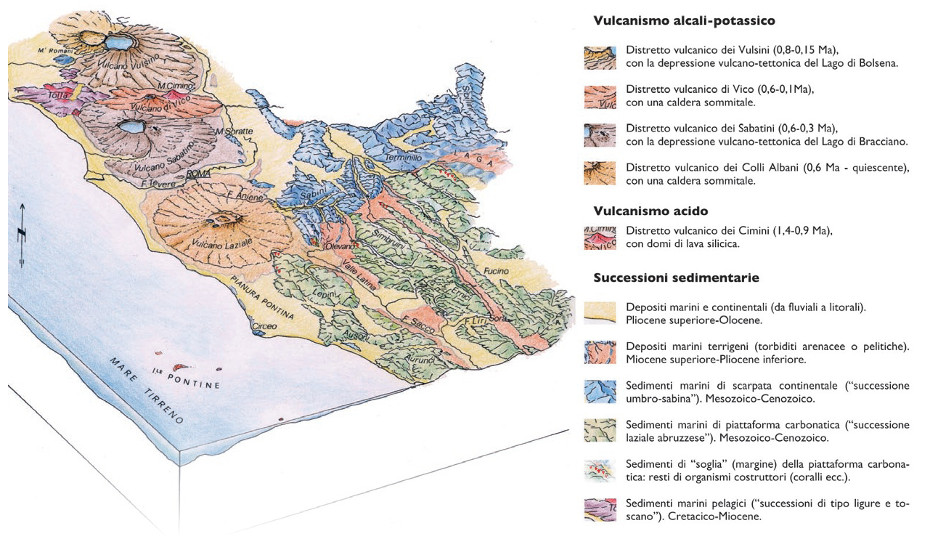
 Current structure of the Campagna Romana
Current structure of the Campagna RomanaFour million years ago, the Campagna Romana was covered by a shallow sea which lapped the sides of the Apennine chain, and from which small islands emerged along the Apennine ridge, i.e. the Soratte and Cornicolani mountains. The gradual retreat of the sea had already began due to tectonic movements, causing a general lifting of the area (Figure 2).
Figura 2 - Flowchart illustrating the paleogeography of central Latium, between 3.5 and 2 million years ago. (drawn by M. and R. Parotto). In the foreground, the alignment of lighter coloured sea zones indicates shallow sea beds in correspondence with the structural highs of Ciampino, Tor di Quinto-Monte Mario, Cesano and Martignano (eastern Bracciano Lake). The front section of the flow chart cuts through the structural high of Castel di Guido.
1. Mt. Vaticano Formation (Fm) (Lower Pliocene p.p - Upper Pliocene p.p.) 2. Neoautochthonous deposits (Upper Miocene) 3. Allochthonous terrains of sub-Ligurian units 4. Sabina calcareous-siliceous-marly succession
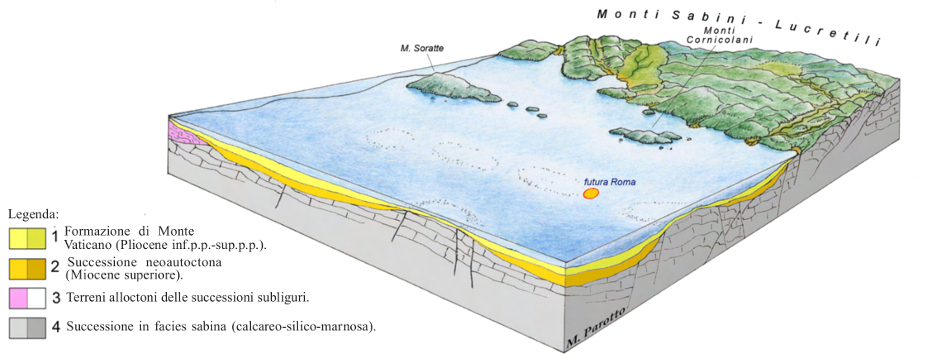
The history of the profound change of the landscape, flora and fauna began about four million years ago: over time, stretches of land once submerged by the sea, progressively emerged and were crossed by rivers, and covered by forests and grasslands. Data which enables us to reconstruct the succession and dynamics of these events are recorded in rocks, and in sedimentary sequences and successions which characterise the area.
Over time new sedimentary deposits have been accumulating on top of each other, like newspapers left in tidy pile day after day. If we browse through this pile of newspapers, we can reconstruct the evolution of news stories. Similarly, the study of rocks enables us to obtain "news" and information for the reconstruction of a story which is sometimes complex, but which enables us to relate each other and with the geological time climatic, paleomagnetic and depositional events, volcanic activity, and variations in composition and structure of flora and fauna.
 Between 3 and 1,5 million years ago
Between 3 and 1,5 million years ago
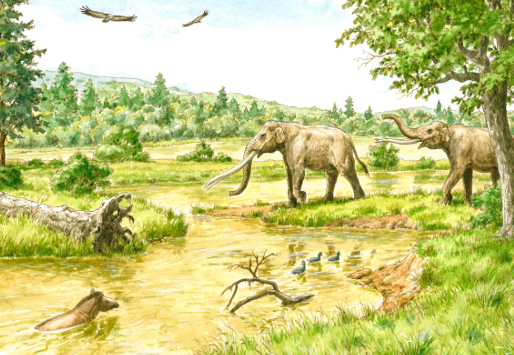 Figure 3 - Artistic reconstruction of a landscape of approximately 3 million years ago in a marsh zone on the slopes of the Cornicolani mountains (drwan by S. Maugeri)
Figure 3 - Artistic reconstruction of a landscape of approximately 3 million years ago in a marsh zone on the slopes of the Cornicolani mountains (drwan by S. Maugeri)
Let us continue our journey back through time: approximately 3 million years ago the coast line, border between the marine dominion and emerged lands, was located in the Westren Cornicolani area (e.g. Palombara Sabina, Rome) at an altitude of approximately 240 metres.
The coastal area was dotted with small lake basins; a warm and humid climate facilitated the development of a dense and rich subtropical vegetation, where Taxodiaceae prevailed, including sequoias.
Near the coast (Figure 3), the accumulation of plant remains in marshlands led to the creation of lignite deposits, where the remains of animals which once roamed the territory, including extinct tapirs (Tapirus arvernensis) and mastodons (Anancus arvernensis), were discovered about two hundred years ago.
Profound changes occurred in both the marine and terrestrial domains when the climate cooled 2.6-2.5 million years ago, which affected the Earth's entire surface, marked the dawn of the Quaternary (or what was once referred to as the "Ice Age").
The global climatic change caused significant modifications in the structure of plant and fauna communities, promoting the dispersal and arrival of species adapted to cooler, more arid climates and quite open spaces (e.g. the first Mammuthus representatives and stenonoid horses). These species progressively spread from Asia west- and sotuhwards, gradually replacing the species strictly adapted to warmer and more humid climatic conditions. The renewal of fauna initially affected herbivore communities, then the carnivore one, with the arrival of some canids, felids similar to jaguars and a large hyena, Pachycrocuta brevirostris, with a short muzzle and teeth capable of breaking stout bones of large mammals.
No mammal remains attributable with certainty to the long-time gap from the middle Villafranchian and the beginning of the late Villafranchian have been discovered in the Campagna Romana. despite the emergence of new lands. However, Mammal remains, consisting of southern mammoths, mastodons, sabre-toothed tigers, hyenas, rhinos and giant deer have been, howerver, discovered in southern Latium, at Coste San Giacomo (Anagni). The fauna provides some information on the animal population which roamed the region approximately 2 million years.
 Between 1,5 and 0,8 million years ago
Between 1,5 and 0,8 million years agoLe antiche linee di costa ben preservate e osservabili lungo il margine occidentale del Pre-appennino Umbro-Sabino (dorsali montuose dei Monti Amerini, Monti di Narni, Monti Sabini, Monti Lucretili e Monti Cornicolani), indicano come il progressivo ritiro relativo del mare sia ancora in atto, l’alto strutturale di Monte Mario è in sollevamento L’antico corso del Tevere passa a Ovest del M. Soratte e raggiunge la costa con un ampio delta nell’attuale area di Magliana-Ponte Galeria (Figura 4).
Figure 4 - Flowchart illustrating the paleogeography of central Lazio, between 1.5 and 0.8 million years ago.
Key: 1. Fault 2. Fosso della Crescenza Fm 3. Ponte Galeria Fm 4. Mt. delle Piche Fm 5. Mt. Mario Fm 6. Mt. Vaticano Fm 7. Meso-Cenozoic basement. (drwan by M. and R. Parotto).

 Figure 5 - Artistic reconstruction of a hypothetical landscape of the Tiber Valley approximately 1.4 - 1.0 million years ago, populated by mammoths, characterised by slightly curved tusks (Mammuthus meridionalis), slender limbed equids (Equus altidens), medium-large size deer (“Pseudodama eurygonos”) and primitive bison (Bison degiulii). (drawn by S. Maugeri)
Figure 5 - Artistic reconstruction of a hypothetical landscape of the Tiber Valley approximately 1.4 - 1.0 million years ago, populated by mammoths, characterised by slightly curved tusks (Mammuthus meridionalis), slender limbed equids (Equus altidens), medium-large size deer (“Pseudodama eurygonos”) and primitive bison (Bison degiulii). (drawn by S. Maugeri)
The continuous alternation of climatic phases (with the increasingly rapid alternation of humid and arid global climate periods and gradual reduction in temperature), coupled with changes in the vegetation, favoured dispersal events of some large mammals and the local evolution of others (Figure 5). In the Campagna Romana a molaroform tooth of Mammuthus meridionalis was found in marine sands cropping out at Monte Mario. A small primitive bison (Bison degiulii), whose skeleton discovered near Rome at Capena, first appeared as well as slender-limbed stenonoid horses (Equus altidens), rhinos (Stephanorhinus hundsheimensis) and large hippos (Hippopotamus antiquus), whose remains were discovered in the ‘50s, in the gravels of the Redicicoli quarry (Rome).
 Between 0,8 and 0,5 million years ago
Between 0,8 and 0,5 million years agoDuring the late Early Pleistocene a profund change in the Earth climate systems occurred: glacial/interglacial oscillations lengthened and intensified, the duration of cycles increased from approximately 41,000 to 100-125,000 years. Around 850,000 years ago, a drop in average temperatures and an increase in aridity triggered an important renewal phase in the mammalian fauna and significant changes in the paleogeographic setting of the Campagna Romana. An intensification in the uplift of the structural highs of Monte Mario, and probably Cesano, caused the ancient course of Tiber to deviate towards S/SE. The new course triggered the reorganisation of the fluvial network in the foothill area. Conversely, in the Southern Latium the Paleo-Sacco Valley opened from the Simbruini-Ernici mountains towards N-W (Figures 6 and 7). Since more than 0.7 million years ago, the progressive building of the Sabatini volcanic apparatus, ant the beginning of the volcanic activity of the Alban Hills led to a further variation in the courses of the Tiber and Sacco rivers.
Figure 6 - Flowchart illustrating the paleogeography of central Lazio, between 0.8 and 0.6 million years ago.
Key: 1. Fault 2. Sedimentary units related to the Tiber River activity (from the Flamina Sintema to the Fiume Tevere (Sintema) 3. Fosso della Crescenza Fm 4. Ponte Galeria Fm 5. Mt. delle Piche Fm (and other underlain pre-Pliocene deposits, not outcropping) 6. Mt. Mario Fm 7. Mt. Vaticano Fm 8. Meso-Cenozoic basement. (drwan by M. and R. Parotto).

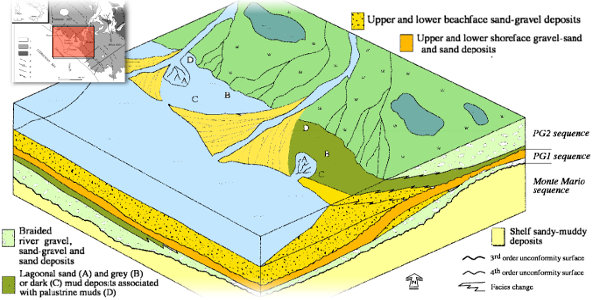 Figure 7 - Palaeographic scheme and depositional model of the Ponte Galeria area (modified from Milli et al. 2004).
Figure 7 - Palaeographic scheme and depositional model of the Ponte Galeria area (modified from Milli et al. 2004).
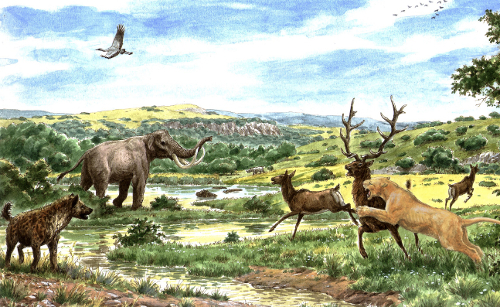 Figura 8 - Ricostruzione artistica di un ambiente di prateria arborata della Campagna Romana nel Pleistocene Medio inferiore, abitata da grandi carnivori (Crocuta crocuta), elefanti (Mammuthus trogontherii), rinoceronti (Stephanorhinus hundsheimensis) e cervidi di grande mole (Praemegaceros verticornis). (disegno S. Maugeri)
Figura 8 - Ricostruzione artistica di un ambiente di prateria arborata della Campagna Romana nel Pleistocene Medio inferiore, abitata da grandi carnivori (Crocuta crocuta), elefanti (Mammuthus trogontherii), rinoceronti (Stephanorhinus hundsheimensis) e cervidi di grande mole (Praemegaceros verticornis). (disegno S. Maugeri)
During the latest Early Pleistocene new large mammals appeared (Figure 8). The climate became cooler and more arid climate, especially during glacial phases, leading the dispersal and diffusion of boreal rodents similar to today's arctic lemming (Dicrostonyx) and steppe lemming (Prolagurus). During the early Middle Pleistocene, numerous new species progressively appeared in the Campagna Romana, including large carnivores such as the spotted hyena (Crocuta crocuta), wild boars (Sus scrofa priscus), large buffaloes with carinated horn-cores (“Hemibos” galerianus), ancient sheep (Ovis ammon antiqua), giant deer, (Praemegaceros verticornis, Megaloceros savini), large fallow deer with palmate antlers (Dama clactoniana), and the ancestors of red deer (Cervus elaphus acoronatus) and roe deer (Capreolus capreolus suessenbornensis). Two proboscidea showing different morphology and adaptation also reached even the coastal areas: Mammuthus trogontherii and Palaeoloxodon antiquus. The steppe mammoth enlarged his range limits from Asia towards the south and west as the favourable steppe-grassland habitats extended. The straight-tusked elephant, less adapted to cold climates, dispersed from Africa towards Europe and the Mediterranean area via the Levantine corridor. P. antiquus, one of the most widespread species in the Campagna Romana, survived for over 700,000 years, until the cold phase of the last glacial period.
 Between 0,50/0,45 and 0,13 milion years ago
Between 0,50/0,45 and 0,13 milion years agoNumerous mammals remains have been discovered in the Campagna Romana in deposits whose age ranges about 0.5 to 0.13 million years ago. The presence of volcanoclastic levels in fossiliferour succesions frequently allowed a precise datation of fossiliferous levels (Figure 9).
Figure 9 - Flowchart illustrating the paleogeography of central Lazio, between 0.6 and 0.5 million years ago.
Key: 1. Fault. 2. Volcanic products from Bracciano eructive centers. 3. Tufo giallo della Via Tiberina. 4. Sedimentary units related to the Tiber River activity (from the Flamina Sintema to the Fiume Tevere Sintema). 5. Fosso della Crescenza Fm. 6. Ponte Galeria Fm. 7. Mt. delle Piche Fm (and other underlain pre-Pliocene deposits, not outcropping) 8. Mt. Mario Fm. 9. Mt. Vaticano Fm 10. Meso-Cenozoic basement. (drawn by M. and R. Parotto).

Some of the oldest remains include a Cervus elaphus eostephanoceros antler found in volcanic levels at Cava Nera Molinario (Rome) and the remains of P. antiquus, Bos primigenius from the pedogenised pyroclastic deposits of Palombara Sabina (Rome).
From about 400,000 years ago, interglacials became progressively more temperate and less arid especially the Mediterranean area. The Tiber Valley with its fertile lands, rich vegetation and small lake basins, became a particularly suitable habitat for the flourishing of a rich and varied fauna and increasing numerous archaic human groups (Homo heidelbergensis).
Some species that had characterised previous phases disappeared, and, together with the survived pachyderms, new mammals inhabited the area, such as the first representatives of some extant species (e.g. wolf, red deer and fallow deer). A mosaic of environments was present. Open deciduous forests were home to large-sized cervids with enormous horns (Megaloceros giganteus, also known as the Irish elk), roe deer, red deer and wild boar, wolves, lynxes, leopards and cave bears (Ursus spelaeus). Hippos bathed in pools and rivers which attracted a rich aquatic avifauna Elephants, aurochs, rhinos and fallow deer inhabited semi-wooded grasslands, which with the onset of cooler and more arid climatic conditions, became steppe-grasslands inhabited by horses, lions and new mammoths, more similar to those which sporadically appeared during the coldest phases of the last glacial. (Figure 10).
Figure 10 - Artistic reconstruction of the Tiber Valley in the late Middle Pleistocene. Characterising elements of the fauna include the straight-tusked elephant (Palaeoloxodon antiquus), auroch (Bos primigenius), red deer (Cervus elaphus), and fallow deer (Dama clactoniana), often accompanied by hippos (Hippopotamus amphibius) and rhinos (Stephanorhinus hemitoechus). Wolf (Canis lupus) and fox remains (Vulpes vulpes) are often present in fossil deposits, whereas remains of large carnivores such as the spotted hyena (Crocuta crocuta) and lion (Panthera spelaea), or Barbary macaque (Macaca sylvanus) are rare. Anatidae and anserids dominated avifauna. (drawn by S. Maugeri)
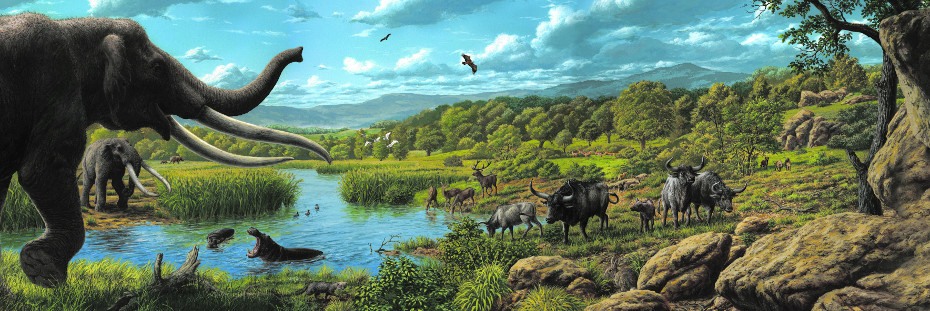
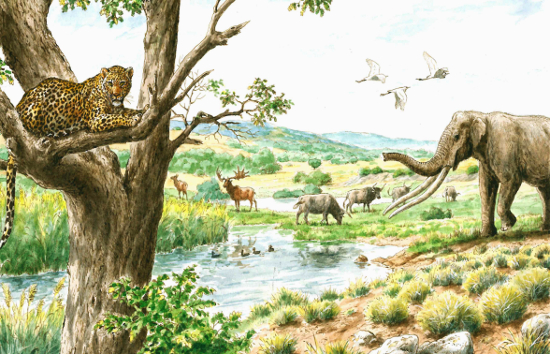 Figure 11 Artistic reconstruction of the Tiber Valley during the last interglacial period. The climate was particularly mild during this period, as documented by a rich Mediterranean flora with Holm oaks, Zelkova, and olive trees. The straight-tusked elephant (Palaeoloxodon antiquus) and aurochs (Bos primigenius), continued to be dominant species, the Irish elk was still present (Megaloceros giganteus), however large carnivores such as the leopard (Panthera pardus), become rare or are altogether absent in fossil records. (drawn by S. Maugeri)
Figure 11 Artistic reconstruction of the Tiber Valley during the last interglacial period. The climate was particularly mild during this period, as documented by a rich Mediterranean flora with Holm oaks, Zelkova, and olive trees. The straight-tusked elephant (Palaeoloxodon antiquus) and aurochs (Bos primigenius), continued to be dominant species, the Irish elk was still present (Megaloceros giganteus), however large carnivores such as the leopard (Panthera pardus), become rare or are altogether absent in fossil records. (drawn by S. Maugeri)
 The last interglacial period
The last interglacial periodThe structure of mammals from the last interglacial period, between around 130 and 70 thousand years ago, was similar to those of previous interglacial eras although this time climatic conditions were, at least initially, slightly warmer.
The increasing warming of interglacials peaked at around 125,000 years ago. The Tiber Valley and its fertile lands, rich vegetation, marshy areas along river banks, developed into a particularly suitable environment for a rich fauna, similar to the fauna that had characterised the two previous interglacial phases (Figure 11).
The last pachyderms, elephants, hippos and rhinos, together with modern fallow deer species were present in grasslands, whereas more open areas were populated by horses, lions and hyenas. The deciduous forests, especially those along the short valleys of tributaries of Tiber, were inhabited not only by Irish elk, roe deer, red deer and wild boar, but also wolves, lynxes, leopards and bears, whereas in cooler periods, the Tiber Valley was also inhabited by steppe species such as the Mammuthus trogontherii.
 The last glacial, Paleogeographic setting
The last glacial, Paleogeographic settingThe last and prolonged phase of climatic cooling that concluded the Pleistocene (consisting in two cold, glacial phases and an interglacial period during which the temperature remained low), determined a more extensive lowering of sea levels (approximately 110 m). The Tiber carved a large and deep valley which extended from the Gianicolo to the Pincio, among the hills where Romolo founded Rome (Figure 12).
Figure 12 - Morphology of the Roman area during the lowstand of the sea in the last glacial phase (Würm).
Key: 1. 1. Tiber River and his tributaries alluvial deposits. 2. Products of Colli Albani Volcano. 3. Products of Sabatini volcanic District 4. Mt.Mario Fm. 5. Fosso della Crescenza Fm. 6. Mt. Vaticano Fm. (drawn by M. and R. Parotto).

With the onset of cooler and more arid conditions, the fauna that populated the Tiber Valley changed. There number of temperate-warm species sensibly decreased. Hippos, straight-tusked elephants and rhinos disappeared from grasslands, while new species arrived. Alpine ibex and chamois populated even relatively lower hills and valley areas, which were also inhabited by numerous herds of B. primigenius and small equid Equus hydruntinus (Figure 13).
Figure 13 - Artistic reconstruction of the Tiber Valley during the last glacial period. During this period the climate was colder than today and conifer forests extended down to the planes at the foot of hills, also inhabited by mountain species such as Alpine ibex and chamois. Pachyderms gradually died out. (drawn by S. Maugeri)
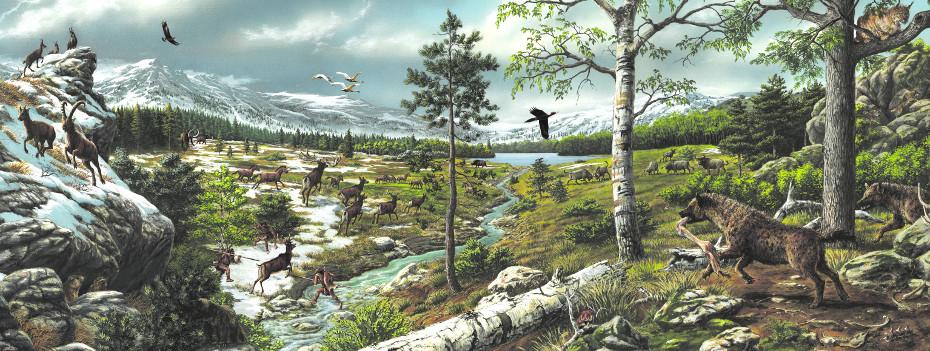
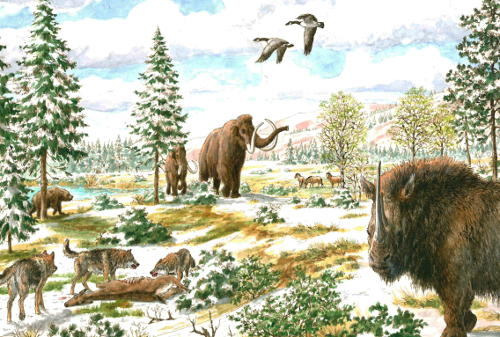 The red deer was frequent, whereas the Irish elk was rarer. The most common carnivore species were wolf and hyena, although the sporadic presence of one of the most aggressive predators of the boreal forests, the wolverine (Gulo gulo), has also been recorded in the Lower Aniene Valley, near to Rome; the woolly mammoth (Mammuthus primigenius) and woolly rhino (Coelodonta antiquitatis) also reached the coastal areas (i.e. Monte Circeo) (Figure 14)
The red deer was frequent, whereas the Irish elk was rarer. The most common carnivore species were wolf and hyena, although the sporadic presence of one of the most aggressive predators of the boreal forests, the wolverine (Gulo gulo), has also been recorded in the Lower Aniene Valley, near to Rome; the woolly mammoth (Mammuthus primigenius) and woolly rhino (Coelodonta antiquitatis) also reached the coastal areas (i.e. Monte Circeo) (Figure 14)
Figure 14 - Artistic reconstruction of planes during the last glacial period.
The wolverine (Gulo gulo), woolly mammoth (Mammoth primigenius) and the woolly rhino (Coelodonta antiquitatis) are typical species of this period, characterised by a cold and arid climate. (drawn by S. Maugeri)
 Towards the modern age
Towards the modern ageFrom approximately 10,000 years ago ices began to retreat and the sea level progressively rose up. The course of Tiber became similar to that crossing the Campagna Romana today.
Approximately 10,000 years ago the Tiber flood plane extended from the Gianicolo - Monte Mario hights, to the northern border of the Alban volcano plateau, shaped by erosion in various hills, including the famous Seven Hills (Figure 15).
Figure 15 - Appearance of the Rome area approximately 10,000 years ago, before then introduction of changes caused by human activity. The Tiber flood plane stretched up to the Gianicolo - Monte Mario and on the opposite end, up to the northern border of the Alban volcano table, articulated by erosion in various hills, including the famous Seven Hills. (drawn by M. and R. Parotto).
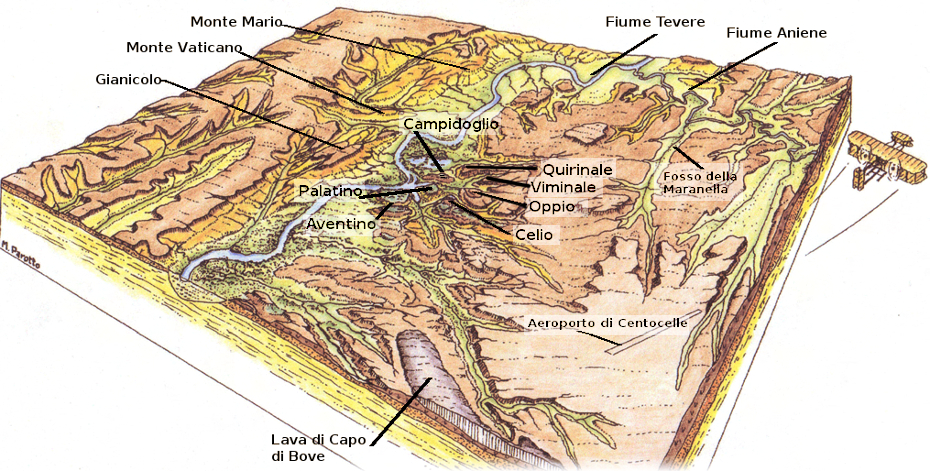
Text: Maria Rita Palombo, Caterina Giovinazzo
Images: Stefano Maugeri, artistic reconstructions of paleoenvironments - www.stefanomaugeri.it
Flowcharts: Maurizio Parotto in: Parotto M. (2008), Evoluzione paleogeografica dell’area romana: una breve sintesi, in Funiciello R., Praturlon A., Giordano G. (Editors) – La geologia di Roma dal centro storico alla periferia. Memorie descrittive dalla carta geologica d’Italia, Vol. LXXX. APAT, Servizio geologico d’Italia, Rome. Figure 7: modified from Milli, S., Palombo, M.R., Moscatelli, M., Anzidei, A.P., Magri D. (2004), Assetto deposizionale e stratigrafia sequenziale della successione del Pleistocene medio-superiore/Olocene del Bacino Romano. II Congresso GeoSed, Roma 22 settembre 2004.